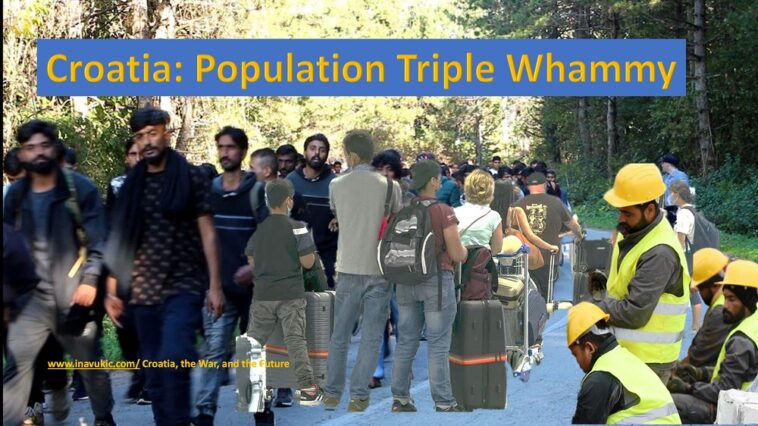Croatia’s population of elder Croatians is soaring, its birth-rate plummets deeper and deeper while increasing droves of working age people leave the country have put Croatia at the forefront of a global demographic trend that experts call a disaster needing an urgent fix in order to retain a national identity and prosperity as we know it. The levels of age and disability pensioners (including disabilities resulting from participating in the 1990’s Homeland War and, would you believe it [!], participating as Yugoslav communist partisan in WWII) compared to levels of taxpayers are so very far apart that the economy itself cannot sustain such a state in retirement and requires increasing reliance on borrowed money for pensions. Certainly, Croatia is not one of the countries that though and planned decades ahead to set up a Superannuation system that would significantly relive the burden on tax funds for age pensions.
There is great deal of movements in Croatia that affect its well-being both politically and economically and spell out national crises of all sorts. Firstly, the relatively excessive loss of population, close to 18% since the War of Independence and subsequent entry as member state of the European Union. Source. In 2022 though, more than 10,000 people came to Croatia than the number that left. That is, 46,287 people left Croatia in 2022, while 57,972 individuals arrived or returned (according to the August 2023 preliminary report by Bureau of Statistics), with a significant number being workers from other countries. Furthermore, an analysis of the data shows that the positive migration balance is partially due also to the arrival of Ukrainian citizens who were fleeing from Russian aggression. However, at the same time, there is also a continuous emigration of Croatian citizens, with emigration increasing by 26% compared to 2021. Hence, population mix is occurring at a rather fast pace so much so that a different character of multiculturalism will be the result, but not by choice of Croatian citizens. Most feel that they have been forced to tolerate cultures that are completely strange and incompatible with theirs and that make them uncomfortable if not bitter. For the time being it is understood that the foreign workers are a temporary fixture to Croatian population as work visas are time limited, however, the economy may dictate the opposite as time goes by and brain and muscle drain from Croatia continues at such high rates into countries with better wages and better working conditions or seeking better education. The January 2023 entry in the Schengen Zone that provides a great deal of fluidity for movements and residence choices to the Zone’s citizens means that people movements between countries may not be labelled as emigration for much longer.
And so, secondly, large number of foreign workers imported into Croatia during the past 18 months even more signifies the drastic loss of Croatian work force to other countries. The foreign workers imported into Croatia have brought a visible clash of cultures feeling of which has surely resulted from the unpreparedness of the domestic population to deal with an entirely different multicultural fabric of daily life than what they have been used to with established several ethnic minorities (all of European descent). The foreign workers though, with their productivity and taxpaying are poised to benefit the economy of Croatia. To add fuel to the fire because of their ethnic characteristics and appearance majority of Croatians see the foreign workers in similar light as they see illegal immigrants. This is troubling because illegal migrants are mainly seen as disturbing the way of life people have been used to and essentially seen as enemies of sort or unwelcome guests.
Thirdly, Croatia is experiencing an ‘unprecedented’ number of migrants crossing its border from neighbouring Bosnia and Herzegovina this summer, with the government working to combat the influx by finalising plans for a new migrant registration hub and building a large registration centre on an abandoned military training ground around the town of Karlovac. This is currently causing much unrest and protest within the domicile population.
Croatia is located on the so-called Balkan route, walked by many illegal migrants originating from the Middle East and North Africa, which sees them travel from Turkey and Greece towards northwest Bosnia and Herzegovina. Once there, they cross the EU’s external border into Croatia from where most intend to reach other EU countries like Germany and France. In fact, the number of incoming migrants this year increased by 170% according to the Croatian Ministry of Interior Affairs and recorded a 700% increase in asylum applications in the country.
Croatian mainstream and other media have become saturated with heart-wrenching stories and plights for help from the local population. They feel that their lives have been infringed and intruded upon by the migrants that walk into their private courtyards stealing food or water, set up camp in their unused field cottages, sleep and defecate in their private forests or agricultural fields, they feel their children can no longer go and play in the local park because the illegal migrants lie or sit there or congregate… For months now the local Croatian population has been living in desperation from wanting its normal life back but unable to due to constant influx of migrants. Amidst questions as to where the illegal migrants should apply for asylum in March 2023 the Croatian government had pushed back into Bosnia and Herzegovina hundreds of illegal migrants who had crossed the Croatian border. How desperate and alarming the situation is can also be seen from public statements Croatian Interior Minister made this past week.
“Last night alone, some 600 illegal migrants were apprehended while attempting to illegally enter Croatian territory – these are unprecedented figures. Everyone who does manage to enter the country has certain rights according to European law, and we respect those rights,” Interior Minister Davor Bozinovic told reporters on Thursday 7 September 2023 while attending a police event near Zagreb.
“However, we will respect their rights by making the rules ourselves. This means we will take them to migration centres in an organised manner,” Bozinovic added, Hina Agency reported.
“It is in everyone’s interest that migrants are moved from the centres of cities and parks. In the facilities above Krnjak (near the town of Karlovac), we can carry out all the administrative tasks that we must carry out in accordance with European and national legislation, and on the other hand, create conditions so that our citizens feel it as little as possible”, he pointed out and noted that the migration pressure, which the whole of Europe is facing, cannot disappear overnight, given that millions of people from mainly Africa and the Middle East see their future precisely on the European continent.
Croatia plans to build a large registration centre at the village of Krnjak, some 20 kilometres south of the major town of Karlovac, on the site of an abandoned military training ground. Last week, about a hundred locals protested the plan and against the setting up of a migrant camp on their doorstep. The protesters insisted that the Republic of Croatia must have greater border control and take care that as few people enter Croatia illegally as possible, and now that number is extremely high and creates problems for the government system and the population. There is a small number of inhabitants in this area, as in many other rural areas in Croatia. The local government had made rather great efforts for people to return to the area, to settle. If an open-type camp is built, it will have negative consequences for the demographics and the area will be abandoned, the protesters asserted.
Evidently, people living in those areas are not ready for what is being imposed on them and asserted that “there are already bad experiences with migrants”, i.e., with thefts, burglaries, and littering. The fear is that these will increase if the migrant camp goes ahead.
“I’m afraid of everything. I am most afraid for the children, the future, the local community, and most of all for the state,” said Dejan Mihaljovic, the Deputy Prefect of Karlovac Municipality.
On Tuesday, 5 September 2023, Bozinovic visited the site and told reporters that the complex includes some 55 buildings suitable for housing people and that the government plans to ask the EU for funding to repurpose the site.
Evidently a great deal of movement and happening is occurring in Croatia that threatens the relative homogenous population profile is concerned as far as ethnic majority and prevalent culture and religion are concerned. It does not matter if some of these movements are considered temporary because there are no indications that the Croatians who have emigrated or those living in the diaspora for decades will return in such large numbers that would improve the demographic picture of Croats living in Croatia. That scenario is a possibility but only with the right political and economic program and the Croatian governments since year 2000 have not had much to offer to make the return of Croats a real and practical choice for most. Political spinning of romantic phrases about love for Croatia as a motive for return can only be stretched so far and to only a few when it comes to realities of living. Considering all that it is more certain than not that Croatian demographics are changing in the race mix and this fact is likely to become permanent rather than stay temporary. The only problem then would be to ensure prevalence of the Croatian ethnic mix to preserve the mainstream culture and language/ Croatian identity. Ina Vukic




